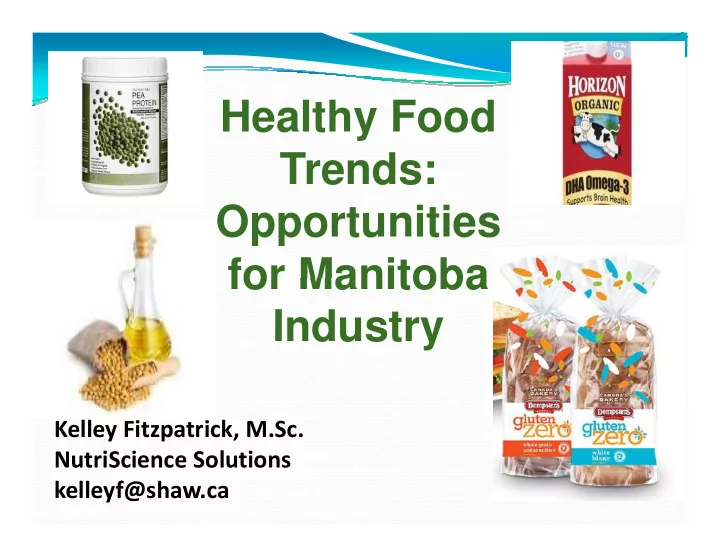

Healthy Food Trends: Opportunities for Manitoba for Manitoba Industry Kelley Fitzpatrick, M.Sc. NutriScience Solutions kelleyf@shaw.ca
Ingredient Trends Protein Healthy fats Antioxidants Pro/prebiotics Pro/prebiotics
Product Trends Digestive Health Plant-based Foods Clean Label Gluten free /“Free” from “Snackification” Sustainability
2016 Consumption Of Ingredients International Food Information Council 2017 64% 3% Protein 4% 60% Fiber 7% 59% Whole grains Vitamins 5% 56% Potassium 7% 48% Natural flavors 9% 41% Omega-3 fats 8% 37% % Try to Probiotics 6% 33% Natural colors limit or limit or 31% 12% 12% 31% Omega-6 fats Omega-6 fats avoid 25% 11% Fortified foods Enriched refined 24% 9% grains 20% 21% Soy 13% 16% Prebiotics 12% 7% Caffeine 12% 36% % Try to Low-calorie 10% 41% sweeteners in general consume 9% 25% Stevia Mono- and poly- 9% 30% unsaturated fats 8% 39% Fats/oils 6% 10% Flavonoids 6% 20% Gluten
New Nutrition Business, Ten Top Trends for 2017
Natural Marketing Institute and Informa Group, P.L.C., 2016.
Grand View Research, 20145 Lux Research, 2015 (reported by Silverwood Partners, 2016)
New Nutrition Business, Ten Top Trends for 2017
Healthy fats • Supported by science • Consumer awareness • Innovation in product development • Global market expected to reach $7.3bn by 2020 • Global market expected to reach $7.3bn by 2020 • CAGR of 13.7% from 2014 to 2020 • Europe – 60% of global consumption • Asia Pacific - CAGR of over 15% from 2014 to 2020 • Functional foods • Largest application segment • Over 55% of global demand, 2013 Frost & Sullivan, 2015
Antioxidants • Understood by consumers • Suggest “fresh” and “natural” • # product segments • Antioxidants have “re-invented” dark chocolate
New Nutrition Business, Ten Top Trends for 2017
Plant Based Foods • Plant-based food industry was ca. $3.5 billion in annual sales (2015) • Growth of 8.7% over the past two years • Compare to 3.7% for • Compare to 3.7% for ‘general’ FB • Plant-based • Meat, tofu, milk, yogurt, cheese and cream – greatest growth SPINS data, 2013 to 2015
20 New Nutrition Business, Ten Top Trends for 2017
New Nutrition Business, Ten Top Trends for 2016
“Clean Label” No regulatory definition Generally accepted as: Removal of chemical sounding ingredients Not easily recognized by Not easily recognized by consumers More “Natural” sounding Simpler, Fewer Ingredients Whole Foods List Healthier Nutrient Profile Non-GMO and Organic claims
Why discuss “Clean Label” In absence of regulatory definition of “clean”, consumers and stakeholders are shaping trend. Over 25% of US products in 2014 - clean label positioning up from 20% in 2013. up from 20% in 2013. 73% of US consumers important to have recognizable ingredients 28% of consumers clean label is important when purchasing foods Innova Market Insights, 2015
% Global food product introductions introductions (bakery, cereals, snacks, pasta & noodles) (Mintel, 2015)
Gluten-free vs. Non-Gluten-free (% of launches by selected claim) Europe A gluten-free product much more likely to also claim organic, low organic, low sugar and fat, no additives or preservative than a ‘regular’ product (Mintel, 2015)
New Nutrition Business, Ten Top Trends for 2017
Over the last decade – 44% increase in people having at least 3 snacks /day New Nutrition Business, 2016
Hartman Group, 2017
New Nutrition Business, Ten Top Trends for 2017
Seven in ten think it is important that the food products are produced in a sustainable way Who is more likely to see it as important? 40% • Age 50-80 • College grads • Women 33% • In better health 12% 10% 3% 1% Very Somewhat Neither Somewhat Very Don't know important important important nor unimportant unimportant enough to unimportant form an opinion IFIC, 2017
Half agree that modern agriculture produces nutritious foods, safe foods, and high-quality foods Strongly agree Somewhat agree Neutral Somewhat disagree Strongly disagree Not sure Produces nutritious foods 20% 36% 26% 5% 9% Produces safe foods 20% 33% 30% 6% 9% Produces high-quality foods 19% 32% 30% 6% 10% Is sustainable 16% 31% 33% 5% 13% Farms are still primarily 14% 23% 24% 16% 13% 11% family-run IFIC, 2017
Summary 1. Does the ingredient/product have some nutritional properties, some science? 2. Has it got marketing muscle and/or media appeal? 3. Offers convenience and snackification 3. Offers convenience and snackification possibilities? 4. Allows creativity with food technology and/or packaging technology? 5. Price – can you get a premium price? 6. Is there a secure supply chain? 7. Which consumer trends does the ingredient connect to?
Recommend
More recommend